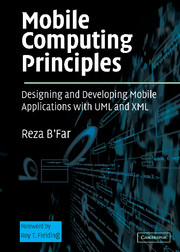Book contents
- Frontmatter
- Contents
- Foreword by Roy T. Fielding
- Acknowledgments
- SECTION 1 INTRODUCTIONS TO THE MAIN TOPICS
- Chapter 1 Introduction to Mobile Computing
- Chapter 2 Introduction to Mobile Development Frameworks and Tools
- Chapter 3 XML: The Document and Metadata Format for Mobile Computing
- Chapter 4 Introduction to UML
- SECTION 2 DEVICE-INDEPENDENT AND MULTICHANNEL USER INTERFACE DEVELOPMENT USING UML
- SECTION 3 ADDITIONAL DIMENSIONS OF MOBILE APPLICATION DEVELOPMENT
- SECTION 4 PUTTING THE PROJECT TOGETHER
- References
- Index
Chapter 4 - Introduction to UML
from SECTION 1 - INTRODUCTIONS TO THE MAIN TOPICS
Published online by Cambridge University Press: 03 September 2009
- Frontmatter
- Contents
- Foreword by Roy T. Fielding
- Acknowledgments
- SECTION 1 INTRODUCTIONS TO THE MAIN TOPICS
- Chapter 1 Introduction to Mobile Computing
- Chapter 2 Introduction to Mobile Development Frameworks and Tools
- Chapter 3 XML: The Document and Metadata Format for Mobile Computing
- Chapter 4 Introduction to UML
- SECTION 2 DEVICE-INDEPENDENT AND MULTICHANNEL USER INTERFACE DEVELOPMENT USING UML
- SECTION 3 ADDITIONAL DIMENSIONS OF MOBILE APPLICATION DEVELOPMENT
- SECTION 4 PUTTING THE PROJECT TOGETHER
- References
- Index
Summary
If one has to jump a stream and knows how wide it is, he will not jump. If he does not know how wide it is, he will jump, and six times out of ten he will make it.
Persian ProverbINTRODUCTION
The unified modeling language (UML) is a standardized language for modeling software systems. Although small systems are easy for a single person or a small group to comprehend and develop, large systems are more difficult to design successfully, since there are often many people and entities controlling different aspects of the system and defining how they should work from their own professional specialty or prerogative. For example, a large company requesting a new piece of software might assign the job to a project manager who has a thorough understanding of the overall system requirements, whereas a software developer assigned to work on the system is likely to care more about the ways that individual portions of a system work on a detailed level and less about the practical requirements of users and management. Similarly, an end user of the system is likely to care about how the user interface is organized and that the software is built to facilitate ease of use for everyday users, rather than that a particular software component was designed exquisitely or that the project fulfills the stated requirements that its originator decided on.
- Type
- Chapter
- Information
- Mobile Computing PrinciplesDesigning and Developing Mobile Applications with UML and XML, pp. 155 - 228Publisher: Cambridge University PressPrint publication year: 2004



